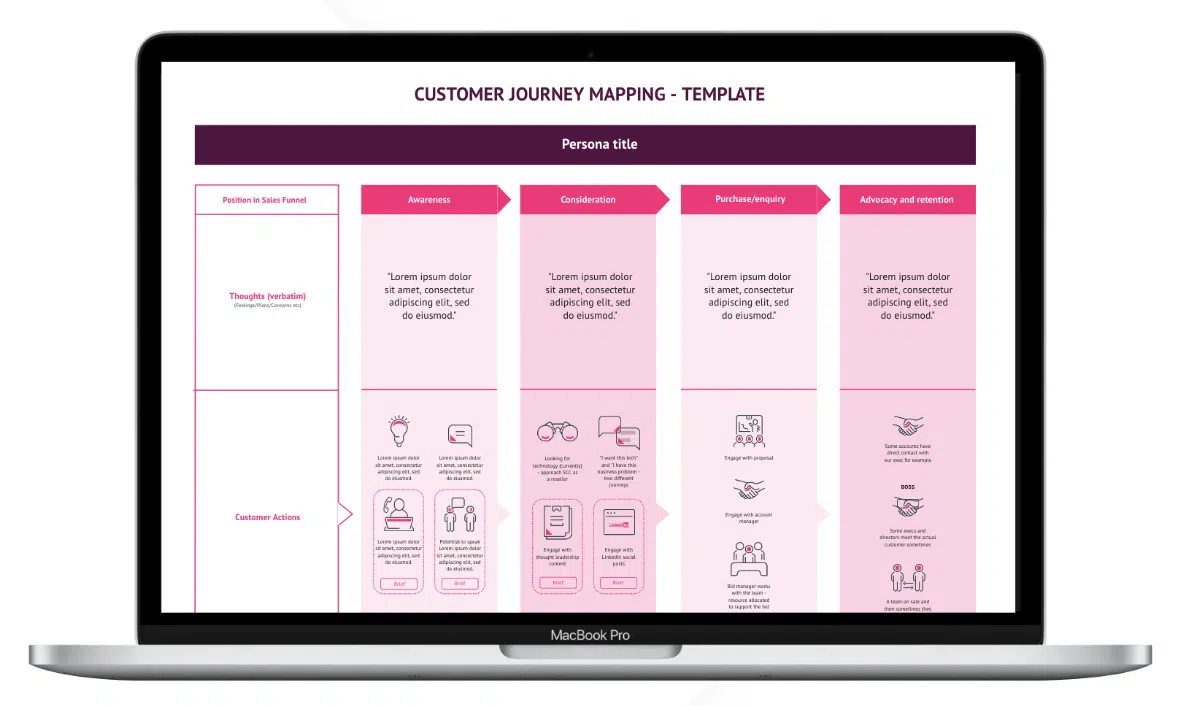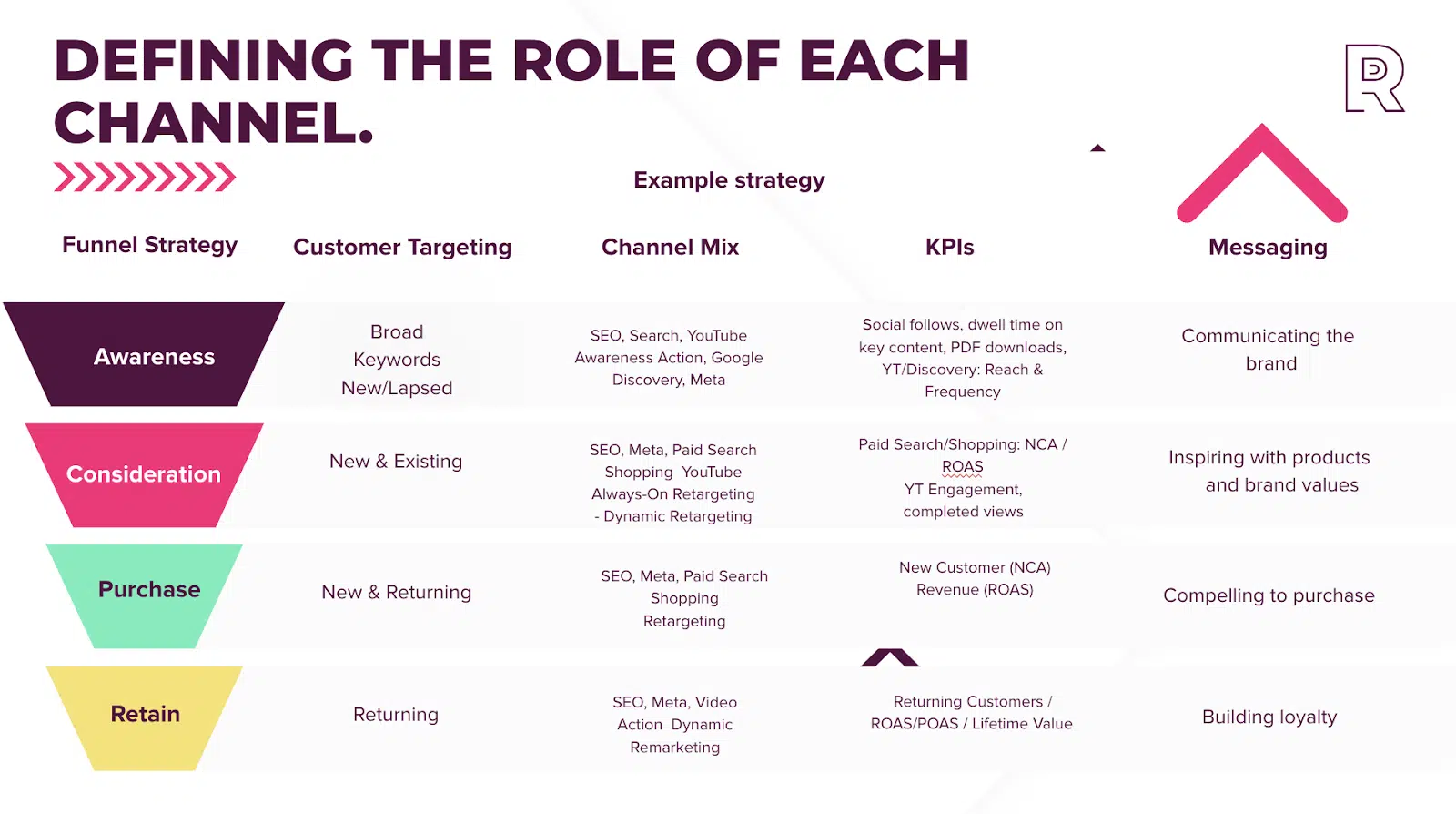How to determine the SEO metrics that matter
Struggling with vanity metrics in SEO? Refocus on impactful metrics driven by customer journeys and elevate your strategic decisions.
Has your boss or client ever question the value of your SEO results because they can’t see the direct revenue?
Do you see some stakeholders get wrapped up in vanity metrics that affect your strategic direction?
We’ve all been there.
This article will help you find a way to get away from vanity metrics and determine the SEO metrics that matter.
We know they do because:
- We’ll let our customers define these – so if they matter to our customers, they should matter to us.
- These metrics are leading indicators. They are much more strategic and give us insight into what we can do to affect the big-money metrics and our future results.
To set the metrics that matter, you need to revisit our search strategy by:
- Defining and understanding your audience.
- Channel research.
- Building your customer journey map.
- Socializing the metrics that matter in your business.
Defining and understanding your audience
Every strategy needs to be built with your audience as the foundation.
As an organization, you should aim for an “outside-in” approach rather than “inside-out.”
An inside-out business will broadcast what they want to say.
They’ll use their language, plan their customer journeys and base many decisions on assumptions.
Outside-in organizations are the complete opposite.
They listen to their audiences, craft their language and base their customer journeys and decision-making on what they learn.
Before you can plan your measurement strategy, you need to know your audience.
- What motivates them?
- What worries them?
- What pushes them forward in a journey?
- What holds them back?
- Who or where do they go for advice?
- How do we do this?
Regardless of the method, it should always be bespoke based on the client, access to data, audiences etc.
Below are some ideas.
Surveys
Use surveys with behavioral science baked in. Avoid leading respondents to the answers you want.
Instead, craft the survey so they can tell you exactly how they feel.
These surveys could be sent to various audiences – your current customers or your marketing email database.
You can work with a market research company to find an audience or a mix of the above.
Social listening
Social listening tools help you find what is being said organically online.
They help:
- Identify trends.
- Gauge sentiment.
- Reveal audience language.
They also offer valuable competitor, partner and publication insights.
Desk research
You likely aren’t the first person to seek audience insights. Existing studies can offer valuable leads to explore.
Client persona workshops
In your organization, you’ll have colleagues who interact directly with customers, like sales or customer service teams.
Persona workshops leverage their knowledge to validate hypotheses or test findings.
1-2-1 interviews
Like workshops, 1-2-1 conversations unlock potent insights when you find the right person to talk to.
Remember, it’s a small sample, not your entire strategy. They validate or create hypotheses.
Align these individuals with your customer-centric strategy for success.
CRM analysis / existing data analysis
Businesses often possess valuable yet untapped data. This research uncovers practical uses, from quantitative data on customer journey timelines to qualitative review trend analysis.
After selecting research methods and conducting them, the data must be analyzed and aligned with customer personas. These personas go beyond demographic details to focus on:
- Motivations.
- Thoughts.
- Feelings.
- Actions.
Channel research
With your audience research nearing completion, you can look at the channels for more learning.
Your research should have surfaced some channels the audience regularly uses, but you may also have other thoughts on channels to validate.
The aim here is to gather as much quantitative data as possible to understand the size of the audience opportunity on the varying channels. You should be aiming to cover:
Keyword research and search trends
Unearthing how the customer searches (and aligning this to the funnel based on keyword intent) is a big puzzle piece in most projects like this.
Also, consider the trends:
- Is there seasonality?
- What affects search volume positively and negatively?
The obvious starting point is Google and Microsoft Advertising. But think wider when it comes to where people go to search (i.e., hashtags on social, YouTube, etc.)
The data points here will be important for prioritizing your strategy based on impact.
Audience insights and targeting
Using the different search and social channels to understand how you might be able to find your audience based on what you now know about them, can you draw any insights from this?
What size are the varying audience buckets? How might you be able to target them at different stages in the journey?
Competitor / partner / retailer reviews
Understanding what your competition is doing and how they perform is always helpful when planning a strategy.
This is no different when you think about audiences.
With the deeper understanding of your audiences that you now have, looking to your competitors and your peers to see their approach can be eye-opening.
Digital PR / social media trends
Looking at the content out there to see what has been popular and how this relates to your audiences is a powerful exercise.
The power of influence, whether from influencers, the collective social audience or publishing businesses, is high.
Having this angle in your research is a must.
Current performance audit
With all of this research complete, you must consider your performance.
Without understanding where you are now, it is irresponsible to plan where you are going, as you don’t know the size of the task.
This performance audit will also help you prioritize actions and manage expectations.
Building your customer journey map
You are now the oracle of information on your customers and many of their key touch points – what now?
You need to turn this into your customer journey map. This is where you will see your KPIs start to appear.
The map can be formed however you wish. Our tool of choice is Miro – for its fluidity in moving information around.
The board needs to be laid out, covering the customer journey. My preference for the stages are:
- Awareness.
- Consideration.
- Purchase/Inquiry.
- Retention and advocacy.
You may wish to split these differently based on your customer journey, but these are standard.
The key job here is creating a map for each persona… sorry, I know that is a lot of work, but trust me – it will be worth it!
For each persona, you should aim to map the following for each stage of the journey:
- What they are thinking.
- What they are feeling.
- What they are doing or aiming to do.
- The touch points (your channel opportunities).
- Any behavioral insights e.g., pain points, push points etc.
- KPIs.
This should all come from your research and, in many cases, will have data points to back up your information.
- Tip: Use key information on the map and link to spreadsheets with deeper dive data and insight.
From a strategic viewpoint, focus on the opportunity’s size, like understanding search volume if Google is crucial for a specific audience during a particular journey phase.
Also, assess your performance to prioritize tactical actions.
To make this clearer, use a map with colored dots (red, amber, green) for performance ratings and stars for major opportunities.
There’s no right or wrong way to present your customer journey. The key here is that it is useful to you and your business.
Below is an example of a tidy, nicely designed journey. I find a clean and tidy version useful to present to the business.

But this is not what it looks like when in flow.
My work-in-progress version (covered in colored dots and stars) is the one I work from and keep most up to date.
Now I know promised you that this article would help you set the measurement framework for your strategy.
If you haven’t spotted it already, we’ve actually just done that.
After mapping each persona’s journey stages, touchpoints, and their thoughts, feelings, and actions, you gain a clear view of their actions or desired actions. These are the actions you aim to track.
These are leading indicators for your strategy. They gauge audience content engagement and, with time and analysis, aid in predicting money metrics.
At a high level, you should be able to build a map (like the example below) to define the different roles of the channels and their purpose within the strategy.
Awareness metrics include:
- Engagement
- Newsletter signups
- Downloads
- Video views
- Social follows
- Pinterest / image engagement
- Saves/wish list
- Next page flow
- Scroll depth
- Dwell time
Consideration metrics include:
- Many of the awareness metrics are still valid, plus…
- Live chats
- FAQ interactions
- Review interactions
- Specific, more detailed content views, scroll depth etc.
Purchase/inquiry metrics include:
- Sales and inquiries
- Bookings
- Telephone call tracking
- Add to basket (opportunity for an abandon basket follow-up and remarketing)
- Online to in-store visibility
Retention metrics include:
- Downloads
- Newsletter sign-ups
- Newsletter engagement
- Returning user rate
- Social engagement – likes/shares/comments
- Use of refer a friend discount code
To recap, customer research shapes our strategy.
Customers inform buying habits, preferences, and journeys for personas based on motivation.
This reveals key channels and actions to track forming a customer-centric strategy.
The next key step is to ensure you socialize this information within the business and get buy-in – you want everyone aligned on your strategy.
Socializing the metrics that matter in your business
It’s crucial to guide the business through the journey you’ve worked on for weeks or even months.
Ensure they understand that customers have shaped this strategy, which holds immense power for future decisions.
The strategy provides transparency into actions before user conversion.
When performance falls short, clear data points reveal the why. Additionally, you can test and learn for performance enhancement.
Consider using psychological nudges to make this information resonate effectively.
The customer journey must drive your SEO measurement strategy
Research involving customers and desired audience, even within channels, uncovers customer priorities.
Remember, what’s crucial for customers matters for you, too. This understanding guides metric selection across the journey and for different audiences.
Getting this right unleashes digital performance.
Leading indicators improve your strategy throughout the journey, rather than relying solely on big money metrics without insight into hits or misses.
For success, secure business buy-in and ensure everyone understands the essential metrics.
Opinions expressed in this article are those of the guest author and not necessarily Search Engine Land. Staff authors are listed here.
Related stories
New on Search Engine Land
